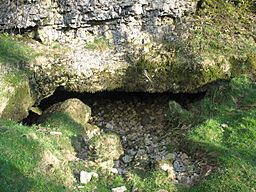Pate Hole facts for kids
Quick facts for kids Pate Hole |
|
|---|---|

The entrance to Pate Hole
|
|
| Location | Great Asby, Cumbria, England |
| OS grid | NY 678 121 |
| Depth | 33 metres (108 ft) |
| Length | 970 metres (3,180 ft) |
| Elevation | 195 metres (640 ft) |
| Geology | Carboniferous limestone |
| Entrances | 1 |
| Difficulty | III |
| Hazards | flooding |
| Cave survey | On Cavemaps |
Pate Hole is a cool cave found right next to Asby Gill in Cumbria, England. It's about 1 kilometer (0.6 miles) south of Great Asby. This cave is super long, stretching for about 970 meters (3,182 feet)! It also goes down quite deep, about 33 meters (108 feet). Usually, the entrance is dry, but when there's a lot of rain, it turns into a powerful gushing spring! The name 'Pate Hole' comes from an old word for 'badger'.
Contents
Exploring Pate Hole's Passages
Pate Hole has three main tunnels, or passages, that explorers can follow.
The Main Entrance Passage
From the entrance, you can walk stooping low into a passage that heads southeast. After about 330 meters (1,083 feet), you'll reach a big pool of water, about 6 meters (20 feet) deep. A stream flows out of this pool.
The Northern Stream Passage
The stream from the big pool flows down a low passage towards the north. It goes for about 270 meters (886 feet) until it reaches a "sump." A sump is a part of a cave passage that is completely filled with water, so you have to dive through it.
The Southern Underwater Passage
The third main passage goes south from the big pool, completely underwater. It stretches for about 225 meters (738 feet) and is about 27 meters (89 feet) deep! This passage eventually reaches a junction but becomes too narrow to go any further.
How Pate Hole Was Formed
Pate Hole was formed in a type of rock called Carboniferous limestone. This kind of limestone was created during the Carboniferous period, millions of years ago. Water slowly dissolved the rock over a very long time, creating the cave passages.
Scientists believe that the water flowing through Pate Hole comes from an area called Great Asby Scar, about 3 kilometers (1.9 miles) to the southwest. The water that comes out of Pate Hole during floods is thought to be the same water that feeds St. Thomas's Well in Great Asby.
A History of Exploration
People have known about the main part of Pate Hole for a very long time. It was a place that made people curious way back in the 1800s!
Early Discoveries
- In 1791, a short trip into the cave was written about in The Gentleman's Magazine.
- In 1802, another description of the cave appeared in The Monthly Magazine.
- The first full description, including how long the passages were, was published in 1813.
Modern Caving Adventures
- The first time cavers explored Pate Hole was in 1941. Members of the Yorkshire Ramblers' Club went into the cave.
- In November 1946, a group from Appleby Grammar School, led by Brian Price, made a detailed map of the cave.
- In 1960, brave members of the Cave Diving Group were the first to dive into the upstream sump. They went about 10 meters (33 feet) into a deep crack. At this time, the main part of the cave was mapped again by Warburton and others.
- More exploration happened in 1975 and 1976 by the same diving group. They pushed further into the cave, reaching the deepest and furthest points known today!

